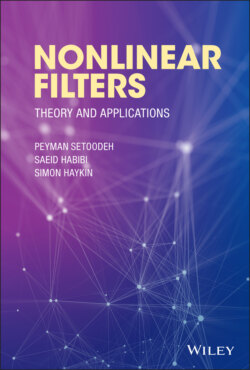Читать книгу Nonlinear Filters - Simon Haykin - Страница 18
2.4.1 Continuous‐Time LTI Systems
ОглавлениеThe state‐space model of a continuous‐time LTI system is represented by the following algebraic and differential equations:
(2.3)
(2.4)
where , , and are the state, the input, and the output vectors, respectively, and , , , and are the system matrices. Here, we need to find out when an initial state vector can be uniquely reconstructed from nonzero initial system output vector and its successive derivatives. We start by writing the system output vector and its successive derivatives based on the state vector as well as the input vector and its successive derivatives as follows:
(2.5)
where the superscript in the parentheses denotes the order of the derivative. The aforementioned equations can be rewritten in the following compact form:
(2.6)
where
(2.7)
and
(2.8)
Initially we have
(2.9)
The continuous‐time system is observable, if and only if the observability matrix is nonsingular (it is full rank), therefore the initial state can be found as:
(2.10)
The observable subspace of the linear system, denoted by , is composed of the basis vectors of the range of , and the unobservable subspace of the linear system, denoted by , is composed of the basis vectors of the null space of . These two subspaces can be combined to form the following nonsingular transformation matrix:
(2.11)
If we apply the aforementioned transformation to the state vector such that:
(2.12)
the transformed state vector will be partitioned to observable modes, , and unobservable modes, :
(2.13)
Then, the state‐space model of (2.3) and (2.4) can be rewritten based on the transformed state vector, , as follows:
(2.14)
(2.15)
or equivalently as:
(2.16)
(2.17)
Any pair of equations (2.14) and (2.15) or (2.16) and (2.17) is called the state‐space model of the system in the observable canonical form. For the system to be detectable (to have stable unobservable modes), the eigenvalues of must have negative real parts ( must be Hurwitz).
